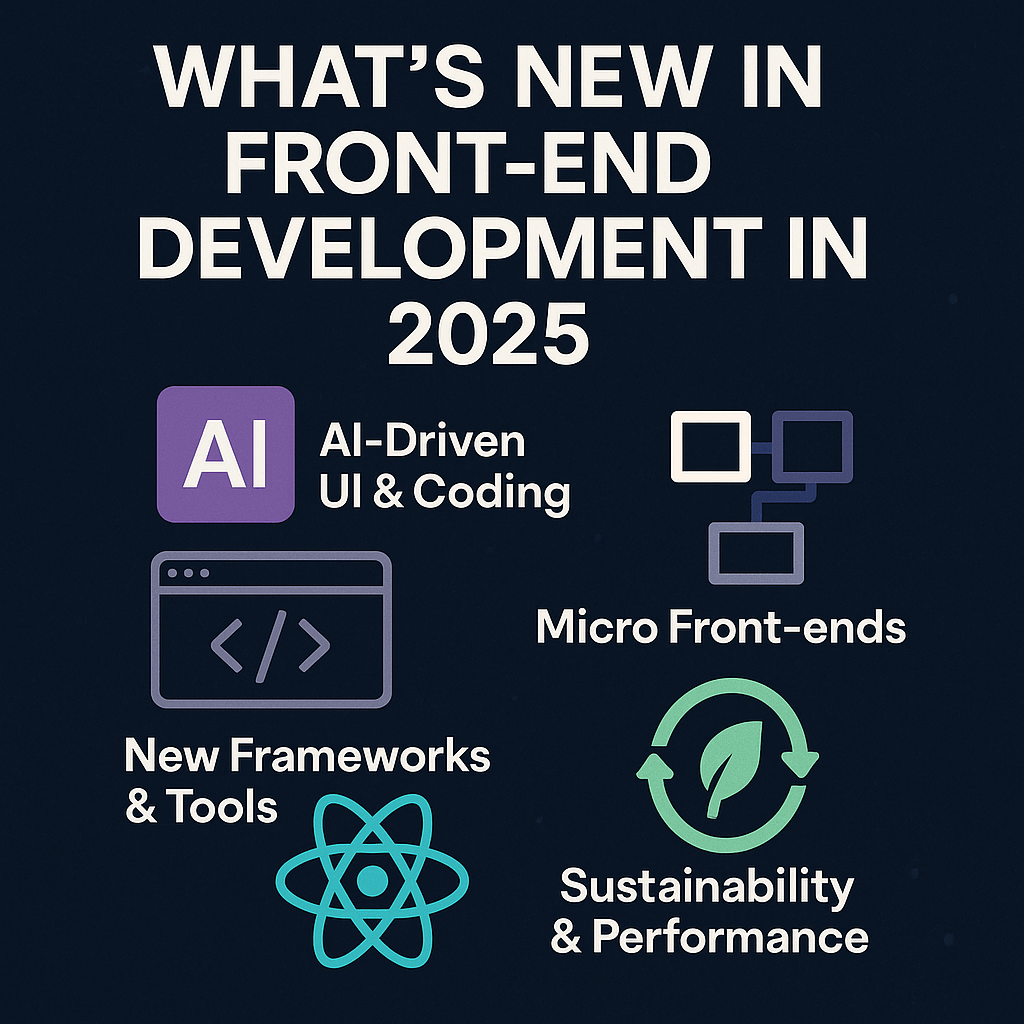Blog 

Aug 18, 2025 - 5 MIN READ

Frontend in 2025: Trends, Innovations, and What Developers Must Know
A look at what changed in frontend development in 2025 — trends, tools, and skills every developer needs to stay relevant.
Rodion Gavrilov
What’s New in Front-end Development in 2025: Trends, Innovations, and What You Must Know
2025 has already proven to be one of the most dynamic years yet for front-end development. From AI and sustainability to new architectures and tools—let’s explore the trends shaping the modern web and what developers should focus on to stay ahead.
1. AI-Driven UI & Coding Workflows
- AI Makes Its Mark: AI tools are transforming how developers build UIs.
At Google I/O 2025, Google unveiled Stitch, an AI-powered design-to-code tool that converts natural-language or image-based descriptions into UI designs and CSS/HTML or Figma formats.
This streamlines the journey from idea to implementation.
2. Progressive Web Apps & Micro Front-ends
- PWAs Still Persist, But Fading?
Progressive Web Apps remain used—though confidence has dropped, with only ~35% of surveyed developers projecting growth, down from 42% in 2022.
Apple’s brief removal of PWA support in iOS 17.4 shows the technology faces both support and skepticism. - Micro Front-ends
Breaking complicated SPAs into smaller, independently developed pieces using module federation or Web Components continues gaining traction for scalable UI development.
3. Servers, Frameworks & Architectures
- Meta-Framework Explosion
New, server-first frameworks are emerging, including SvelteKit, Astro, Remix, SolidStart, Qwik, Fresh, and Analog, alongside major upgrades to Next.js and Nuxt. - Next.js Evolutions
Next.js keeps advancing with React Server Components, the App Router, and the Rust-based Turbopack introduced in v15. - Svelte 5 & SvelteKit
Svelte 5 (released in late 2024) revamped reactivity with new runes and reusable snippets.
Early 2025 brought experimental features like asynchronous reactivity and remote functions in SvelteKit.
4. Performance, Rendering & Bundling
- Modular Hydration & Adaptive Rendering
React (and Next.js) are pushing fragment-based hydration—deferring non-critical components to improve metrics like Time to Interactive and First Input Delay. - Super-Fast Bundlers
Tools like esbuild, written in Go, offer dramatically faster build times (10–100× faster than older bundlers).
It now powers Vite and Angular 17.
5. No-Code / Low-Code & Component Design
- Democratizing Builds
No-code and low-code platforms remain popular—enabling non-developers to prototype and even build live apps faster.
But developers are still essential for performance-sensitive apps. - Component Libraries & Design Systems
Lightweight libraries like shadcn UI let devs copy individual components for highly customized designs without heavy dependencies.
6. Sustainability, Accessibility & Developer Experience
- Green Web Design
Growing focus on lean code, image optimization, and efficient APIs reduces energy consumption and carbon footprint. - Accessibility & Dev Experience (DXP)
Accessibility compliance and improved developer experience are now seen as core responsibilities, not optional extras.
7. Framework Landscape & Tooling Snapshot
- Popular Frameworks: React, Vue.js, and Angular remain dominant.
Svelte, Preact, SolidJS, and other lightweights continue to grow. - HTMX Resurgence: HTMX enables interactivity with simple HTML attributes, avoiding heavy JS frameworks for smaller projects.
- Tauri for Desktop Apps: Tauri v2 provides cross-platform (desktop/mobile) apps using a Web frontend with a Rust backend—offering a leaner alternative to Electron.
📌 Summary: What Should Front-end Developers Focus On?
| Area | What to Watch / Learn |
|---|---|
| AI Tools | Use AI tools like Google’s Stitch for faster UI and code generation. |
| New Architectures | Learn SvelteKit, Remix, Qwik, modular rendering, and micro front-ends. |
| Performance & Bundling | Master esbuild, Turbopack, adaptive rendering. |
| Core Competencies | Deepen JavaScript, TypeScript, accessibility, sustainability, performance. |
| Dev Tools / Workflow | Explore shadcn UI, HTMX, and no-code platforms as productivity boosters. |
| Cross-Platform Apps | Experiment with Tauri for desktop and mobile builds. |
Final Thoughts
2025 is a thrilling year for front-end development—AI, advanced rendering, sustainability, and new frameworks are all changing how we build for the browser.
For developers aiming to stay current, the key is balancing strong fundamentals with exploration of these emerging tools.